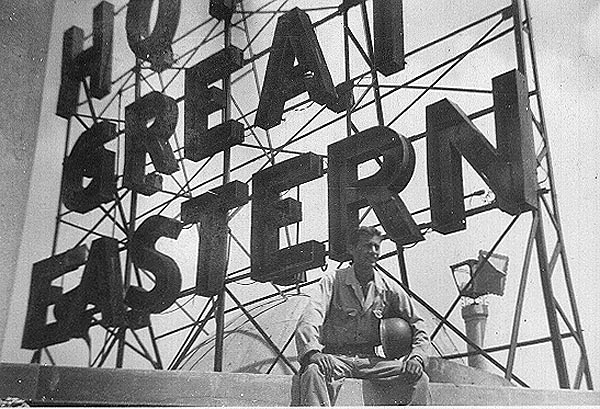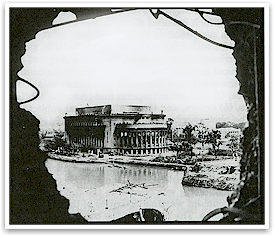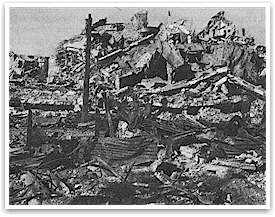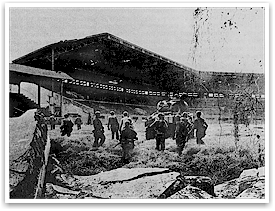12 Feb
45 - The Philippine General Hospital complex, all its
buildings of reinforced concrete, extended west along the north
side of Herran Street about 550 yards to Dakota Avenue. North,
across Padre Faura Street lay equally sturdy buildings of
Philippine University. All hospital buildings were clearly marked
by large red crosses and contained many Filipino patients now held
hostage by the Japanese. XIV Corps had initially prohibited
artillery fire on the buildings, but lifted the restriction on 12
February when the 148th Infantry discovered that the hospital was
defended. The presence of the civilian patients did not become
known for another two or three days. (S. p. 286)
13 Feb
45 - The 148th Infantry, having fought every step of the
way from the Estero de Paco, began to reach Taft Avenue and get
into position for an attack on the hospital. Its left flank
extended along Taft Ave from Herran south four blocks to Harrison
Boulevard, the 148th Infantry-12th Cavalry boundary. The
infantry's extreme right was held up about three blocks short of
Taft, unable to advance until the 129th and 145 Infantry overran
the New Police Station strongpoint. The Japanese had all the
east-west streets east of Taft Avenue covered by automatic weapons
emplaced in the hospital and university buildings. The 148th could
not employ those streets as approaches to the objectives.
Accordingly, the regiment prepared to assault via buildings and
back yards on the east side of Taft. (Ibid)
14 Feb
45 - The 2nd Battalion, 148th Infantry, (with 2nd
platoon, Co. C, 82nd CMB, attached) at the cost of 22 killed and
29 wounded, could make only negligible gains in trying to push
west across Taft Avenue. The Japanese stopped the American
battalion with mortar, machine gun and rifle fire from the Science
Building and adjacent structures at the northwest corner of Taft
and Herran, from the main hospital buildings on the west side of
Taft between California and Oregon, and from the Nurses Dormitory
at the northwest corner of Taft and Isaac Peral. (Ibid)
4.2 OP party rings bell on sniper
Still east of Taft Avenue and moving south
with the 2nd Bn., 148th Infantry, through a residential area on a
narrow street parallel to and one or two blocks east of Taft, the
2nd platoon, Co. C's OP party was hugging walls and darting from
cover to cover of any wrecked vehicle or debris available. The
members were strung out attempting to keep 10 yards apart. One
would stay put until the one ahead had dashed to new cover and all
movements were running erratically, bobbing and weaving. The
equipment visible (not as easy to hide as in the jungle) made all
of the party targets: Butler's Tommy gun, Phillips' SCR-300 radio,
Ward's bazooka, and Shaeffer's 3.5-in. Rocket backpack.
At an intersection with another narrow
street was a church on the southeast corner – the steeple made it
a suspicious, scary sight. Darting around the corner of a wall
that bordered the narrow sidewalk, diagonally opposite the church
and with lots of noise from rifles, machine guns, and 60-mm.
mortars, Butler jabbed his left hand vigorously pointing toward
the steeple and fired a short burst at it, alerting the rest of
the party to the potential hazard. Then, WHAM! Butler sensed,
rather than heard, the thud of the Jap's bullet as it struck the
wall above his head. Without thinking, he dove head first off the
sidewalk into the street. A very narrow gutter (drainage space
along the curb, called a jube in Iran and where Indonesian women,
their teeth stained red from the beetle nut and their flowing
skirts held high, squatted to urinate in Noumea, New Caledonia)
offered the lowest depression for cover against the sniper. With
only his left kneecap in the gutter, the rest of him struggling to
get into it off the sidewalk and the inability to get his head
lower and still keep the "steel pot" on it, Butler was no longer a
moving target (fortunately, the gutter was dry.) He was "dead
meat" for the sniper.
No church bell ever sounded sweeter than
the bell from that belfry, as it and the belfry's other
occupant(s) were blown to Hell by Ward's bazooka. The bell banged
and clanged on the pavement below to herald a fanatical Nip
enroute to Shinto Heaven.
Forward, or die, the OP party cautiously
moved in broken-field mode toward Manila Bay behind the slowly
advancing infantry. Maybe 100 yards short of Taft Avenue was a
bunker on a corner, covered with earth, from which grew grass.
Thinking it might provide welcome cover, Butler darted for it,
only to find it was packed tight with wooden boxes of ammunition.
During the night, a tremendous explosion
rocked the area. Next morning that bunker loaded with Jap
ammunition was gone. In its place was a water-filled crater with
one Filipino corpse on the lip of the crater. There may have been
more and they may have attempted to remove some boxes, which
probably were booby-trapped. The corpse most likely was one of two
or more in the party and he was far enough away to be killed by
concussion without disappearing in the blast.
The progress made by the 148th Infantry
during the 14th had depended largely upon heavy artillery and
mortar support. The 140th Field Artillery fired 2,091 rounds of
high-explosive 105-mm. ammunition, and 4.2-inch mortars of the
82nd Chemical Mortar Battalion expended 1,101 rounds (almost 14
tons in one day) of high explosive and 264 rounds of white
phosphorous. The white phosphorous, setting some fires in a
residential district south of the hospital, helped the advance of
the 3rd Battalion on the left (south), but neither this or the
high-explosive shells appreciably decreased the scale of Japanese
fire from the hospital and university against the 2nd Battalion.
(S. pp. 286-87)
16
Feb 45 - In the midst of the fighting in the stadium area, south
of Harrison Blvd. in the 1st Cavalry Division area –
see Map 6 – the 1st Cavalry Brigade, less the 2nd
Squadron, 12th Cavalry, passed to the control of the 37th
Division. General Beightler directed the brigade to secure all the
ground still in Japanese hands from Harrison Park north to Isaac
Peral Street – fifteen blocks and 2,000 yards north of Harrison
Boulevard – and between the bay shore and Taft Avenue. The 5th
Cavalry, under this program, was to relieve the 148th Infantry,
37th Division, at another strongpoint while the 12th Cavalry, less
the 2nd Squadron, was to make the attack north along the bay
front. The 12th's first objective was the prewar office and
residence of the U.S. High Commissioner to the Philippines on the
bay at the western end of Padre Faura Street, three blocks short
of Isaac Peral. (S. p. 279)
Also on the 16th, the 1st Battalion, 148th
Infantry, relieved the 3rd Battalion which had made the large wide
sweep to the beach (see Map 6 above) and would now hold that beach
while the 12th Cavalry took over its sector to the north.
Company C, 82nd CMB, would continue
4.2-inch mortar support to the 148th Infantry elements in contact
and would furnish that support to the 5th Cavalry and 12th Cavalry
units as they replaced the infantry.
17 Feb
45 - With the aid of support fires, the 2nd Battalion,
148th Infantry, smashed its way into the two most easterly of the
hospital's four wings and overran the last resistance in the
Nurses' Dormitory and the Science Building. (Ibid)
Frankel reports: “Before noon the 2nd
Battalion had entered both the Hospital and the Nurses' Home
(Dormitory)... Shortly after 1300, the battalion reported
occupation of the Science Building, Administrative Building, the
Nurses' Home (Dormitory), and the forward part of the Hospital.”
(F. 37th, p. 281)
An estimated seven thousand civilians were
rescued in the (hospital) area, two thousand of them being removed
that afternoon while battle casualties were hustled across the
open area on litters. These civilians were of American, European,
and Oriental extractions and were frightened and bewildered. The
Japanese had held them so that Americans would not use
large-caliber guns. When the Yanks finally forced their way into
the Hospital, some of the Japs became crazed and belatedly
attempted a wholesale slaughter of the noncombatants. (F. 37th, p.
282)
Shortly after a
C-ration lunch, the 2nd Battalion, in the face of point-blank
machine-gun fire, rushed down corridors of the Hospital and by
1430 held two wings as well as the Dispensary. The Japanese still
clung to the cellar. Through the middle of the day, fighting at
close quarters ripped the sector. Later in the afternoon the
battalion pulled up to the middle wing of the hospital and
established a forward observation post (OP) in the Nurses' Home
(Dormitory). (Ibid)
18 Feb 45 - Map 6 shows
the OP of the 2nd platoon, Co. C, 82nd CMB, in the Nurses'
Dormitory at the northwest corner of Taft and Isaac Peral, the
northeast point of the Philippine General Hospital complex, which
point passed to 1st Cavalry Division control on 23 February. This
was the first "elevated" observation post used by the 2nd platoon
during a month of scurrying, like the rats we were seeking to
destroy, through city streets and yards, and firing on the many
strongpoints encountered by the infantry and the cavalry. All
previous OPs were on the street, wherever the assault infantry
company or cavalry troop commander chose to control the advance of
his troops and designate targets for the 4.2s.
By this time vehicles were coming across
the Pasig on pontoon bridges and McClelland sent the 2nd platoon
jeep with two men of the company communication section, the
jeep-mounted reel of wire and two field telephones, with the ¼-ton
trailer. In the trailer were two 5-gallon cans of water, a case of
C rations and a case K rations. Fortunately the trailer tarp was
tied down to hide that loot. The OP could remain in the Dormitory
and maintain contact with the supported company or troop
commander. Once one phone was hooked to the wire reel and strapped
to a concrete support pillar in the dorm, the two men with jeep,
one phone, and the wire reel were sent to join the commander; the
trailer stayed at the foot of the fire escape. It also helped that
Butler could talk to the troop commander and advise him of the
situation as seen from a stationary position 30-40 feet above
street level.
There was still no wire across the Pasig
from gun position to OP, so Phillips with the SCR-300 remained on
the 3d floor of the dorm, but stayed well to the rear where he
could extend the antenna out a rear window space. Ward and
Shaeffer were stationed, with bazooka and carbines as guards for
the OP and the trailer, at the foot of the fire escape. From our
Bougainville days, we all knew not to expect more than two hours
sleep at a time. Easy to remember: 2 on, 2 off. Not that any
target for a bazooka was anticipated but, if there should be one,
it was less likely to appear on the 3rd floor than at the foot of
the fire escape.
The Dormitory was a very sturdily built,
reinforced concrete structure with high ceilings (about 15' high)
and huge openings where windows used to be. All stairwells and
interior walls were gone and access was only by fire escapes on
the side away from the street. Concrete pillars, about twenty
inches wide on each of the four sides, were spaced uniformly about
every ten feet in each direction. They may have marked the
arrangement of rooms at one time, but no rooms existed when the OP
was established. The Japs may have removed all walls and other
debris and tossed it out into the courtyard, perhaps in
preparation for fortifying the Dormitory as a strongpoint guarding
the approaches to Intramuros.
Also occupying the 3rd floor OP, which had
been established during the afternoon of the 17th by 2nd
Battalion, 148th Infantry, was an artillery sergeant directing
105mm. artillery fire. Others, mostly officers, occasionally
climbed the fire escape for a view of the Bay and surrounding
features. One morning a Lt. Col. came up about dawn, stood in a
window space looking south with his binoculars, and was promptly
shot through the head. End of story, never learned who he was or
where from. Frankel mentions a Lt. Col. Richard D. Crooks, who had
been commander of 1st Battalion, 129th Infantry, and “...had been
killed by enemy rifle fire while making a forward reconnaissance
on February 14.” (F. 37th, p. 284) The 148th Infantry had not
secured the Nurses' Dormitory until the 17th.
19 Feb 45 - At 1100, the
12th Cavalry, having relieved the 148th Infantry troops along the
bay, launched its attack north by the 1st Squadron, opposed by
considerable rifle, machine gun and 20-mm. machine cannon fire
from the High Commissioner's residence and from private clubs and
apartment buildings north and northeast thereof. (S. p. 279)
20 Feb 45 - Behind close
artillery support, the cavalry squadron attacked early and by 0815
had overrun the last resistance in the High Commissioner's
residence and on the surrounding grounds. The impetus of the
attack carried the squadron on through the Army-Navy and Elks
Clubs and up to San Luis Street and also through most of the
apartments, hotels, and private homes on the east side of Dewey
Boulevard from Padre Faura north to San Luis. Only 30 Japanese had
been killed in this once-important Manila Naval Defense Force
command post area; the rest had fled into Intramuros or been used
as reinforcements elsewhere. The 1st Squadron, 12th Cavalry, lost
3 men killed and 19 wounded during the day. (S. pp. 279-80)
Discrepancy: In
the above account, Smith describes the cavalry's action at the
High Commissioner's residence as “Behind close artillery
support...” Kleber and Birdsell quote the 37th Division assistant
chief of staff, G-3, after witnessing the chemical mortars in
action before the High Commissioner's residence, as saying that
“direct support infantry weapons, particularly 4.2-inch mortars,
falling close to our own lines, were found to neutralize the enemy
where penetration took place.” This report by Kleber and Birdsell
is in the context of their summation of the actions by the 82nd
Chemical Mortar Battalion in support of the XIV Corps from
Lingayen Gulf to Manila. (K&B. p. 506)
Note: The
above by Kleber and Birdsell is followed immediately by a
summation of actions on Luzon by the 85th Chemical Mortar
Battalion, which had landed near San Fabian in the Lingayen Gulf
on 28 January with the 1st Cavalry Division. (Ibid)
4.2s rake Manila Hotel and MacArthur's
penthouse
19 Feb 45 - During
daylight, Butler had registered his platoon's battery of four
4.2-inch mortars, still firing from Malacanyan Palace, on several
potential targets beyond the friendly front lines as shown on the
18th (Map 6). This usually consisted of firing a few WP rounds on
intersections or buildings clearly in Japanese hands. The
five-story Manila Hotel, with its visible penthouse, was a prime
suspect. Registration was done only with the number 1 mortar-all
others would fire parallel to it, unless directed to "close
sheaf," in which case they would adjust onto number 1's impact, or
"open sheaf by X yards," whereby they would spread the fire X
yards left from each other. The registration on the Manila Hotel
was limited to the area between a concrete wall and the hotel
buildings. The penthouse was an ideal observation post for the
Japanese, although there were no enemy guns visible from the
Dormitory.
20 Feb 45 - The 148th
Infantry had been relieved by the 12th Cavalry along Manila Bay,
while the OP of the 2nd platoon, Co. C, 82nd CMB, remained in
place. The OP came under fire from 20mm. or 40mm. Japanese guns
firing from the grounds of the Manila Hotel west of Dewey
Boulevard (Map 6). After dark, shells impacted on the outer wall
of the Nurses' Dormitory, fortunately not entering through the
wide window spaces. The location of the OP may have been disclosed
by the fatally unfortunate action of the Lt. Col. who was killed
on the 18th. As the Jap guns fired, their flashes illuminated the
yellow wall of the Manila Hotel just behind. Apparently, the Jap
gunners were in the process of registering on the Dormitory.
Sergeant Mills was given the order to
start firing HE on the registered data, "volley 1 round and walk
it out at 10-yard increments." Advised that the target was the
guns firing at the OP from between the wall and the building, plus
the 5-story hotel and its penthouse, he calculated charges and
elevations to keep a steady stream of four HE shells moving from
the wall, across the courtyard, and up the building at about
10-yard intervals. Butler's observations satisfied him that the
first two volleys were effective against the Jap guns. He was then
able to "fine tune" subsequent volleys to keep them moving up the
new west wing and onto the penthouse. By the fifteenth volley (60
rounds of HE) the penthouse and any OP it housed were destroyed.
No more fire from that source.
Having had the Manila Hotel under
observation from late afternoon on the 17th throughout the night
of the 20th, with no fire directed against it prior to the rolling
barrage of 4.2s from 2nd platoon, Co. C, 82nd CMB, it is
surprising to read from Smith:
The South Port area lay just northwest of
the Manila Hotel, the next objective. In preparation for the
attack on the hotel, the 82nd Field Artillery Battalion
intermittently shelled the building and surrounding grounds
throughout the night. A patrol of Troop B dug in along the
northern edge of Burnham Green to prevent the Japanese from
breaking out to reoccupy abandoned bunkers in the open park area.
With artillery support and the aid of two
105-mm. self-propelled mounts and a platoon of medium tanks, the
1st Squadron dashed into the hotel on the morning of 21 February.
... Nevertheless, the hotel's eastern, or old, wing was secured
practically intact by midafternoon. Some Japanese still defended
the basement and the new (west) wing, but the cavalrymen cleaned
them out the next day. The new wing, including a penthouse where
General MacArthur had made his home, was gutted and the general's
penthouse was demolished. (S. p. 280)

The
author, Lt. Jack Butlerpictured at the OP atop the nine-story
Great Eastern Hotel, Rizal
Avenue, Manila, 23 February 1945. Butler commanded 2nd platoon.
Comment: The
82nd Chemical Mortar Battalion did not operate through corps or
division artillery fire direction centers; the 4.2s had been found
to be more responsive to the infantry/cavalry by dealing directly
with the "client." In that the above-described action by the 2nd
platoon, Co. C, 82nd CMB, was against a "target of opportunity" in
the face of hostile fire against its OP, there was no need to
notify the artillery any more than with any mission in support of
infantry or cavalry units. Smith's writing, published in 1963,
would have relied in large part on after-action reports, the
filing of which was pretty much a matter for commanders to decide.
As noted, Carlisle's Lines
From Luzon has
shortcomings. As 82nd CMB S-3 (Operations), he would be the one
most likely to know what the firing units were doing. On the
morning of the 21st, following the 4.2-inch mortar fire on the
Manila Hotel the previous evening, Butler left Phillips in the
Dormitory OP with the SCR-300 radio and the OP field phone. He
would receive and relay communication between Butler and the
mortar position north of the river at Malacanyan Palace. The 2nd
platoon jeep and wire team was called in from the 2nd Battalion,
148th Infantry, which had been relieved in that sector by 5th
Cavalry troops.
Butler went with the jeep and telephone
team west toward the bay and north until he located a 12th Cavalry
troop commander and his command post (CP) about 500 yards south of
the Manila Hotel, which his troop was then assaulting. The captain
was sitting on a sidewalk with his back to a garden wall, a field
phone and runners keeping him in touch with his platoons and the
squadron CP. His patrols had reported earlier that the west wing
of the hotel (closest to the beach) had no windows and Jap
resistance was concentrated in the basement. There seemed to be no
immediate need for further 4.2 support, so the 2nd platoon OP
party returned to the Dormitory and reported to McClelland at his
CP, co-located with all three firing platoons of Company C, 82nd
CMB, on the Palace grounds.
Note: On
22 February, General MacArthur watched the battle and was
horrified to see his home (the penthouse) set afire. He entered
the hotel, escorted by machine-gunners and found the penthouse and
its contents had been reduced to ashes (Richard Connaughton, et
al, The Battle For Manila,
Presidio Press, Novato, CA, 1995, p. 156).
Kleber and Birdsell have nothing more to
say about 82nd CMB in Manila after the quotation they attribute to
the AC of S, G-3, 37th Division, regarding the effectiveness of
4.2-inch mortars at the High Commissioner's residence (see 20 Feb
45, above). Smith, however, includes action by Company I, 145th
Infantry, (on 22 Feb 45) in which “...4.2-inch mortars (of Co. A,
82nd CMB) and 81mm. mortars (infantry) plastered the roof and
upper floors (of the City Hall) with indirect fire.” (S. p. 284)






